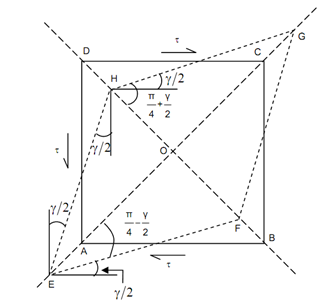Relationship between E and G:
Figure illustrated what is known as the state of pure shear. The deformation of the body because of the shear is illustrated in Figure (projected view).

The state of stress on the element is specified by the stress component S, τxy =- τ yx = τ . Because of shearing strain the original plane ABCD (a square) gets distorted into a rhombus EFGH. The magnitude of the shear strain γ is specified by change in the right angles ∠ BAB, ∠ ABC, ∠ BCD and ∠ CDA. This change is generated by rotations of pairs of lines by γ /2 such as ∠ DEH.
By using Equation (31) and (32), let us discover the stress components on the diametral planes
DB and AC whose aspect angles are respectively π/4 and 3π /. On plane DB, we get
Normal stress component, σ = τ sin 2θ
= τ sin 2π/4 = τ
Shear stress component = τ cos 2θ
= τ cos 2π/4 = 0
Likewise, on plane AC,
Normal stress component = τ sin 2θ
= τ cos 2π/4 = 0
Shear stress component = τ cos 2θ
=τ cos 2 × ( 3/4 ) π = 0
Therefore, the distortion of the square ABCD by shear stress might also be treated as due to the elongation of the diagonal AC because of normal stress of + τ on planes parallel to BD and shortening of the diagonal due to normal stress of - τ on planes parallel to AC.

ε OA = τ/E -v (- τ/E) = τ ((1 + v)/E)
ε OB = τ/E -v (- τ/E) = τ ((1 + v)/E)
OE = OA (1 + ε OA)
OF = OB (1 + ε OB)
φ = OEF = π/4 - γ/2
tan φ= tan (π /4- γ/2 ) = (1 - (γ/2))/ (1+ (γ/2))
From Figure,
tan φ= OF/OE = OB (1 + ε OB )/ OA (1 + ε OA )
= OB (1 + ε OB )/ OB (1 + ε OA ) (Q OA = OB)

Comparing Eqs, we get
γ/2 = τ/ E (1 + v)
or shear strain
γ= 2 τ (1 + v)/ E
Rigidity Modulus G = Shear stress/ Shear strain
= τ / (2τ/ E) (1 + v)
G = E / 2 (1 + v)